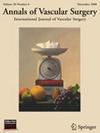预压线圈塞法在髂内动脉栓塞中的疗效观察。
IF 1.6
4区 医学
Q3 PERIPHERAL VASCULAR DISEASE
引用次数: 0
摘要
在血管内动脉瘤修复(EVAR)中,髂内动脉(IIA)栓塞有时是必要的。预压线圈-塞(P-CIP)技术允许在受限区域内进行高密度栓塞。本回顾性研究评估了P-CIP技术的疗效,并将其与传统线圈栓塞(CE)进行了比较。方法:2015年1月至2023年12月,201例患者行EVAR。73例患者行IIA主干栓塞术。仅使用Amplatzer血管塞或使用Amplatzer血管塞2进行P-CIP栓塞的患者被排除在外。56例患者(平均年龄76.7岁,女性11例)分为P-CIP组(25例)和CE组(31例)。结果:两组患者栓塞部位血管直径(8.08±1.9 mm vs 8.01±2.2 mm, P=0.85)、手术时间(36.4±3.1 min vs 34.0±3.1 min, P=0.45)、2型内漏发生率(0 [0%]vs 1 [3.2%], P=0.27)差异无统计学意义。与CE组相比,P- cip组需要更少的线圈(3.36±0.26 vs 4.30±0.24;P=0.037),完全闭塞率明显更高(19 [76.0%]vs 10[32.3%])。结论:P- cip技术能够有效可靠地栓塞IIA主干,比传统CE具有优势。本文章由计算机程序翻译,如有差异,请以英文原文为准。
Efficacy of the Preloading Coil-In-Plug Method for Internal Iliac Artery Embolization
Background
During endovascular aneurysm repair (EVAR), embolization of the internal iliac artery (IIA) is sometimes necessary. The preloading coil-in-plug (P-CIP) technique allows high-density embolization within a confined area. This retrospective study at our institution evaluated the efficacy of the P-CIP technique and compared it with conventional coil embolization (CE).
Methods
Between January 2015 and December 2023, 201 patients underwent EVAR. Seventy-three patients underwent IIA trunk embolization. Patients who underwent embolization using only an Amplatzer vascular plug (AVP) or P-CIP using an AVP2 were excluded. Fifty-six patients (mean age, 76.7 years; 11 female patients) were categorized into the P-CIP (25 patients) and CE (31 patients) groups.
Results
The embolization site vessel diameter (8.08 ± 1.9 mm vs 8.01 ± 2.2 mm; P = 0.85), procedure time (36.4 ± 3.1 minutes vs 34.0 ± 3.1 minutes; P = 0.45) and incidence of type 2 endoleaks (0 [0%] vs. 1 [3.2%]; P = 0.27) of both groups were not significantly different. Compared to the CE group, the P-CIP group required fewer coils (3.36 ± 0.26 vs 4.30 ± 0.24; P = 0.037) and had a significantly higher complete occlusion rate (19 [76.0%] vs 10 [32.3%]; P < 0.002). Compared to the CE group, the P-CIP group had a significantly smaller embolization range (20.1 ± 5.46 mm vs. 31.7 ± 7.2 mm; P < 0.001); however, the buttock claudication incidence was not significantly different (13 [52.0%] vs 13 [41.9%]; P = 0.45). All patients experienced full recovery of buttock claudication within 1 year postoperatively.
Conclusion
The P-CIP technique enabled effective and reliable embolization of the IIA trunk and demonstrated advantages over conventional CE.
求助全文
通过发布文献求助,成功后即可免费获取论文全文。
去求助
来源期刊
CiteScore
3.00
自引率
13.30%
发文量
603
审稿时长
50 days
期刊介绍:
Annals of Vascular Surgery, published eight times a year, invites original manuscripts reporting clinical and experimental work in vascular surgery for peer review. Articles may be submitted for the following sections of the journal:
Clinical Research (reports of clinical series, new drug or medical device trials)
Basic Science Research (new investigations, experimental work)
Case Reports (reports on a limited series of patients)
General Reviews (scholarly review of the existing literature on a relevant topic)
Developments in Endovascular and Endoscopic Surgery
Selected Techniques (technical maneuvers)
Historical Notes (interesting vignettes from the early days of vascular surgery)
Editorials/Correspondence

 求助内容:
求助内容: 应助结果提醒方式:
应助结果提醒方式:


